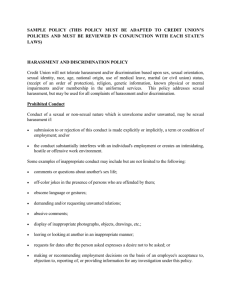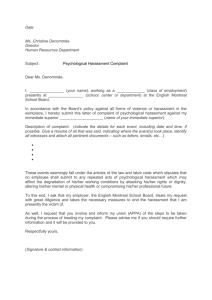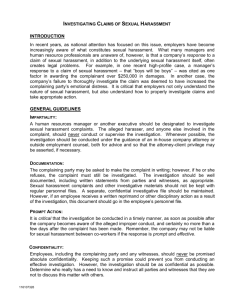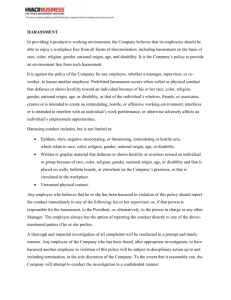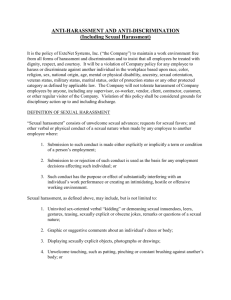Conducting Internal Investigations - National Association of College
advertisement
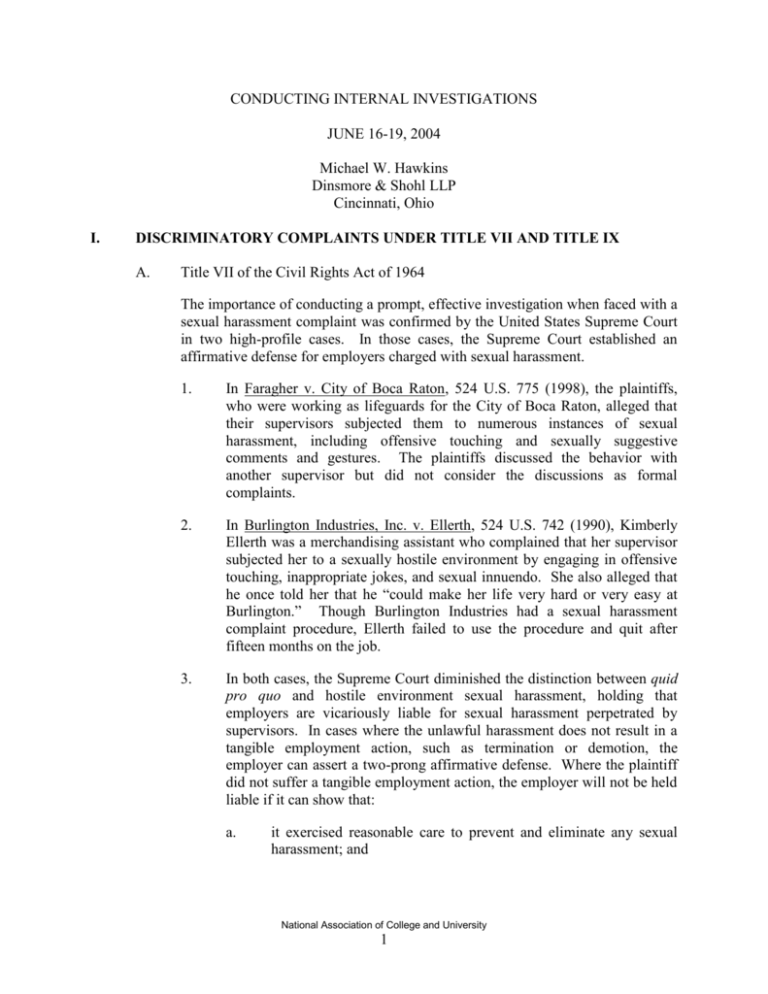
CONDUCTING INTERNAL INVESTIGATIONS JUNE 16-19, 2004 Michael W. Hawkins Dinsmore & Shohl LLP Cincinnati, Ohio I. DISCRIMINATORY COMPLAINTS UNDER TITLE VII AND TITLE IX A. Title VII of the Civil Rights Act of 1964 The importance of conducting a prompt, effective investigation when faced with a sexual harassment complaint was confirmed by the United States Supreme Court in two high-profile cases. In those cases, the Supreme Court established an affirmative defense for employers charged with sexual harassment. 1. In Faragher v. City of Boca Raton, 524 U.S. 775 (1998), the plaintiffs, who were working as lifeguards for the City of Boca Raton, alleged that their supervisors subjected them to numerous instances of sexual harassment, including offensive touching and sexually suggestive comments and gestures. The plaintiffs discussed the behavior with another supervisor but did not consider the discussions as formal complaints. 2. In Burlington Industries, Inc. v. Ellerth, 524 U.S. 742 (1990), Kimberly Ellerth was a merchandising assistant who complained that her supervisor subjected her to a sexually hostile environment by engaging in offensive touching, inappropriate jokes, and sexual innuendo. She also alleged that he once told her that he “could make her life very hard or very easy at Burlington.” Though Burlington Industries had a sexual harassment complaint procedure, Ellerth failed to use the procedure and quit after fifteen months on the job. 3. In both cases, the Supreme Court diminished the distinction between quid pro quo and hostile environment sexual harassment, holding that employers are vicariously liable for sexual harassment perpetrated by supervisors. In cases where the unlawful harassment does not result in a tangible employment action, such as termination or demotion, the employer can assert a two-prong affirmative defense. Where the plaintiff did not suffer a tangible employment action, the employer will not be held liable if it can show that: a. it exercised reasonable care to prevent and eliminate any sexual harassment; and National Association of College and University 1 b. the employee unreasonably failed to take advantage of the employer’s anti-harassment policy and complaint procedures. Since the Supreme Court’s decision in Faragher and Ellerth, courts tend to find that the existence of a well-communicated, effective anti-harassment policy, in conjunction with a prompt, effective investigation, are sufficient to establish the first prong of the affirmative defense. B. Title IX of the Educational Amendments of 1972 1. Faculty/Student Sexual Harassment a. In Franklin v. Gwinnett County Public Schools, 503 U.S. 60 (1992), the Supreme Court found that Title IX may be used as a basis for seeking money damages where a student has been subjected to intentional sexual harassment. b. Shortly before the Supreme Court issued its Faragher and Ellerth decisions, the court considered the case of a high school teacher who had an affair with one of his students in Gebser v. Lago Vista Independent School District, 524 U.S. 274 (1998). School officials claimed they had no knowledge of the affair and that once it was discovered the teacher was fired. The majority of the Court held that school districts cannot be liable for damages in a private lawsuit over teacher/student harassment unless an official in a position to take corrective action knew of the harassment and was “deliberately indifferent” to it. The majority stated “that a damages remedy will not lie under Title IX unless an official who at a minimum has authority to address the alleged discrimination and to institute corrective measures . . . has actual knowledge of discrimination . . . and fails adequately to respond.” The majority opinion stated that Congress probably did not intend violations of Title IX to result in penalties to districts that exceeded their level of federal funding. Lago Vista District had received about $120,000 in federal aid. 2. Student-On-Student Sexual Harassment a. In May 1999, the Supreme Court issued Davis v. Monroe County Board of Education, 526 U.S. 629 (1999). The Court held that a private damage action may lie against a school district under Title IX in cases of student-on-student harassment only where the funding recipient acts with deliberate indifference to the known acts of harassment in its programs or activities and only for harassment that is so severe, pervasive and objectively offensive that it effectively bars the victim’s access to an educational opportunity or benefit. National Association of College and University 2 In Davis, a parent, on behalf of her fifth grade student, sued the school board and officials under Title IX for failing to remedy a classmate’s sexual harassment of her daughter. In holding that a private damage action may lie against the school board under Title IX in cases of student-on-student harassment, the Court held that damages are not available for simple acts of teasing and namecalling even where these comments target differences in gender. In Davis, the plaintiff argued that the school district’s deliberate indifference to the persistent sexual advances towards her daughter created an intimidating, hostile, offensive and abusive school environment that violated Title IX. In finding liability, the Court stated that a recipient’s damages liability will be limited to circumstances where the recipient exercises substantial control over both the harasser and the context in which the known harassment occurs. Where, as in Davis, the misconduct occurred during school hours and on school grounds, the misconduct clearly took place under the control of the recipient. Under those circumstances, the recipient retained substantial control over the context in which the harassment occurred and the school district exercised significant control over the harasser since it has disciplinary authority over its students. II. CONDUCTING AN EFFECTIVE INVESTIGATION A. Pre-Investigation Considerations An effective investigation presupposes the existence of policies and procedures for reporting inappropriate conduct. It is necessary to perform periodic reviews of policies and procedures for handling complaints. In addition, supervisors, managers, or other individuals must be trained regarding the appropriate procedures for handling complaints. B. Investigation Considerations 1. The following situations should prompt consideration of an internal investigation: a. Any type of formal complaint or grievance b. Anonymous tip or report c. A “this isn’t a complaint” report d. Unexplained changes in behavior, morale or productivity e. Suspicion or informal complaint of misconduct National Association of College and University 3 2. 3. 4. 5. f. EEOC or other administrative charge g. Notice of a lawsuit Consider a mini-investigation to determine whether to: a. Place the accused on immediate leave b. Temporarily transfer individuals c. Change supervisory responsibilities d. Be concerned about a safety issue or potential criminal investigation Identify potential witnesses a. Witnesses will always include the complainant and the alleged harasser b. Determine additional witnesses who may know relevant facts Do a preliminary search of available records a. Are there any other documented reports of similar conduct? b. Review the personnel or academic files of the alleged harasser and the complainant Prepare a strategy for the investigation a. Prepare a chronology of events b. Prepare a list of witnesses to interview c. Allow sufficient time to take and/or complete notes between interviews d. The investigation must take place promptly after the report of harassment 6. Prepare an outline of questions 7. Consult handbooks, policy manuals or operating procedures for specific procedures and requirements for conducting an investigation 8. Consider the appropriate investigator. Possibilities include: National Association of College and University 4 9. C. D. a. Supervisors or related human resources officers b. In-house counsel c. Private investigator or outside consultant d. Regular outside counsel e. Special outside counsel If at all possible, select an investigator who is a different person than the decision maker; this will assist in eliminating appearance of bias and provide a second set of eyes to review the facts. Goals of the Investigation 1. Get all the facts 2. Determine whether harassment (or some other form of inappropriate conduct), in fact, occurred 3. Set the stage for potential consequences if inappropriate behavior is uncovered 4. Reduce damages and other related consequences to the complainant 5. Protect others from potential harassment 6. Set the stage for defense of potential litigation Questions that the investigation should answer 1. Who was the alleged harasser? 2. What happened? 3. Where did the incident(s) occur? 4. When did the incident(s) occur? 5. How were the complainant and the complainant’s work and/or academic environment affected? 6. Why did the parties do what they did? 7. Who are the witnesses? 8. How often did it occur? National Association of College and University 5 E. 9. How did the complainant react? 10. Did the complainant discuss the incident with anyone else? 11. What evidence of the documentation or photos? incident exists, such as Due Process Considerations A student who is facing expulsion or suspension from a public educational institution is entitled to due process protections. See Goss v. Lopez, 419 U.S. 565, 575-76 (1975). If the suspension is ten days or less, the student must be given oral or written notice of the charges, an explanation of the basis for the accusation, and an opportunity to present his side of the story. Id. at 581. As the disciplinary consequences increase, so do the necessary requirements for due process. F. III. Review And Update The Investigation Plan During the Course of the Investigation 1. Maintain flexibility to modify the investigation plan 2. Seek additional information when needed 3. If an investigation reveals other instances of harassment, develop a plan for correcting the inappropriate conduct which may include modifying the complaint process, training, staff meetings, or other follow-up. CLOSING THE INVESTIGATION A. Review the legal standards for actionable harassment B. The investigator should organize the record of the investigation and summarize it C. Analyze results of the investigation 1. 2. In reviewing investigation notes, ask: a. Were the witnesses credible? b. Do you know what happened based on what you’ve learned? Determine the outcome a. If you have reasonable evidence that the alleged conduct did occur: • Assess the severity National Association of College and University 6 b. c. IV. • Ensure that the discipline chosen is consistent with past practices • Follow labor agreements, policy, student or faculty handbooks • Document the disciplinary actions taken • Communicate the decision to the complainant and the accused • Do follow up if appropriate with parties and document it If you have reasonable evidence that the alleged conduct did not occur: • Tell the accused employee that the results do not substantiate the complaint/suspicion • Reiterate the harassment policy (if applicable) • Remind all parties that retaliation against the complainant or witnesses is prohibited • Communicate the decision to the complainant • Document your actions If the investigative results are unclear: • Consider a second level of investigation (e.g., law enforcement or private investigators) if appropriate • Continue to monitor the situation 3. Document the results of the investigation and your conversations with the complainant and the accused 4. Keep investigation files current with wrap-up information on the investigation and subsequent activity 5. Protect confidentiality TEN REMINDERS INVESTIGATION 1. FOR EFFECTIVE DOCUMENTATION OF AN The purpose of documentation is to create a record that precisely captures what occurs during interviews, other fact-finding, decision-making, and National Association of College and University 7 implementation phases of every discipline situation. Effective documentation will help satisfy the affirmative defense articulated in Ellerth and Faragher. 2. Be mindful that every note, scrap of paper, telephone message, computer entry, and e-mail message can be reviewed after-the-fact to determine the legal validity of the college or university’s actions. 3. Follow the “New York Times Rule” at all times: Don’t write or say anything which, if it were published on the front page of the New York Times, would embarrass you or the college or university. 4. Supervisors are not taking notes just for themselves. Likely audiences include other supervisors, students, professors, union officials, the person about whom the documents are written, an arbitrator, a lawyer, or a jury. 5. Every document must stand on its own so that anyone who reads it acquires a clear understanding of what the author intended. 6. Document only direct evidence, i.e., what you observe with your own senses. If Employee A tells you that Employee B hit Employee C with his fist, write that Employee A told you that. Do not write, as if it were a fact, that Employee B hit Employee C because you did not observe that yourself. Whether Employee A’s statement is true must be determined later. 7. Use language that is business-related, and avoid words that are crime-related or that reflect moral judgments which could be regarded as defamatory. It is better to say the individual engaged in “inappropriate conduct” rather than “sexual harassment.” 8. Avoid including your opinions, impressions, or interpretations of what is learned during fact-finding. Generally, it is better to discuss these with other decision makers when it is appropriate. 9. Sign and date all documents the day they are created, even if the write-up refers to an interview conducted on another date. 10. Remember: the easiest way to lose a case is to have created documentation that makes the college or university appear to be hiding something or lying about something or to have no documentation at all. Effectively communicating your policies to students, staff and faculty along with a prompt, thorough investigation will give you the tools to successfully address complaints that may cause liability. It will also provide you with the ability to limit or eliminate liability. National Association of College and University 8
